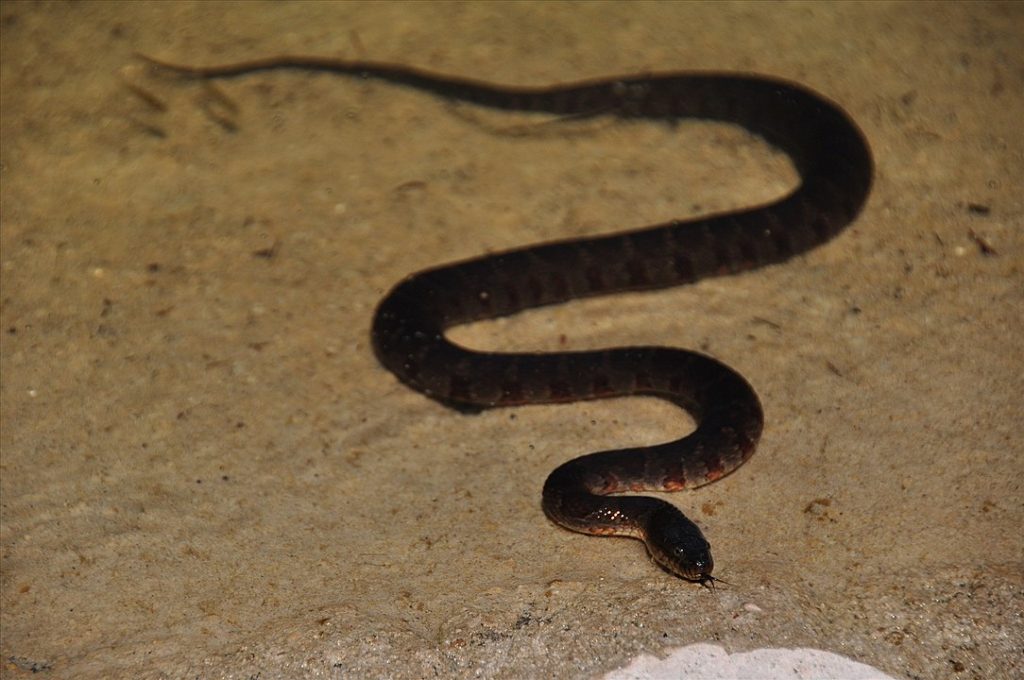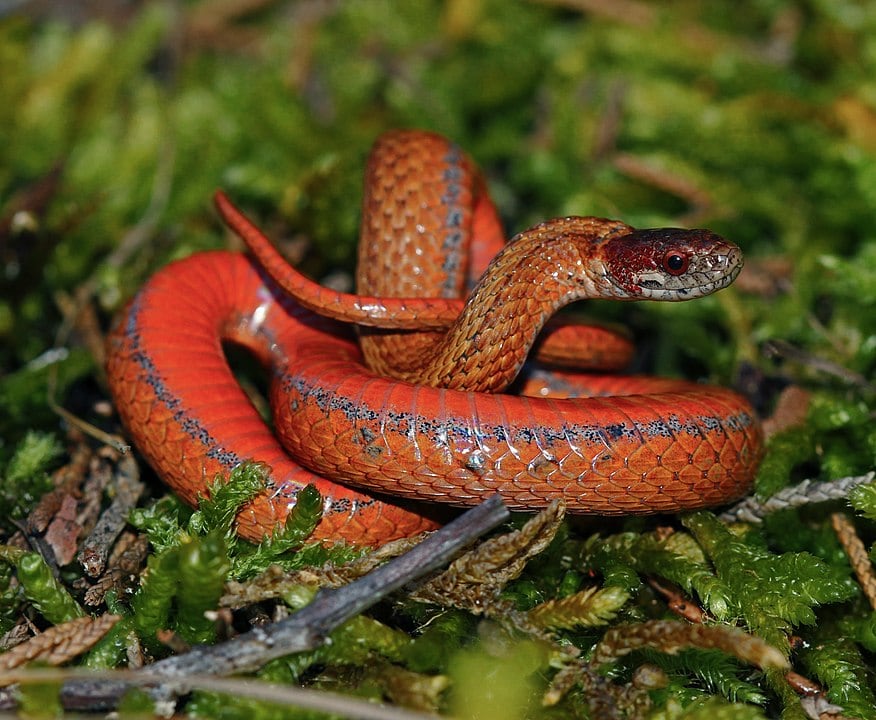New Hampshire is home to eleven snake species, with only one venomous species out of the bunch. This is one of the smallest numbers of species in the country, but it’s still worth looking at. In addition, most are endangered, and authorities are putting efforts to conserve them.

Share This Image On Your Site
<a href="https://outforia.com/snakes-in-new-hampshire/"><img style="width:100%;" src="https://outforia.com/wp-content/uploads/2022/04/Snakes-in-New-Hampshire-infographics-04072022.jpg"></a><br>Snakes in New Hampshire Infographic by <a href="https://outforia.com">Outforia</a>You May Also Like: 15 Most Common Snakes In Tennessee (With Pictures)
The 11 Types of Snakes in New Hampshire
1. Timber Rattlesnake

Timber Rattlesnakes are the only venomous snake species living in New Hampshire. They are found in the White Mountains and are critically endangered.
The species have a triangular head, keeled scales and grow to about 36 to 60 inches (94-152cm) long. They are heavy-bodied and spot the characteristic rattler at the end of their tails. They have brown cross-bands over the length of their bodies which help them to blend with their surroundings.
Their habitats are rocky, forested areas with a lot of cover and sunlight. They busk on rock surfaces during the day and use rock dens as shelter and communal hibernating grounds.
An interesting fact about Timber Rattlesnakes is that they give birth to their young ones and use the same den for generations.
In the summer, males can travel miles away from the den and return before fall to hibernate.
2. Milk Snake

Milk snakes are found throughout New Hampshire, apart from far Northern regions. You can find them in various habitats such as woodlands, rocky hillsides, farmland, and barns. They hide under logs, stones and hips of trash to keep out of sight.
Milk snakes are slender and grow to about 24 to 36 inches (60-90cm) long. They have distinctive red, black and white bands spanning the length of their bodies and a checkered white and black underbelly.
When threatened by predators, they shake their tails rapidly like rattlesnakes as a warning and may even strike. This type of mimicry is known as Batesian, where a harmless species mimics harmful ones to scare predators.
However, they’re non-venomous, and their bite poses minimal danger to humans.
Their mating season is in spring, and females lay eggs during the summer that hatch in late summer early fall.
Milk snakes’ diet consists of other snakes, eggs, lizards, and small mammals.
3. Ribbon Snake

Ribbon snakes are present throughout New Hampshire, apart from the far North. Their numbers are low, and the species enjoys protected status in the state.
They are slender and grow to about 16 to 35 inches long (40-88cm). They have ribbons of yellow or green running down their bodies contrasted by a brown or black background hue. Their tails are long and measure ⅓ of their entire length.
Ribbon snakes are never far from water and inhabit brushy areas near water sources. They are one of the fastest snake species in New Hampshire and live an active, solitary life. However, during the winter, they hibernate underground in small groups.
Their mating season is in the spring, and females give birth to young ones in July through September.
Their diet only includes cold-blooded prey such as fish, salamanders, spiders, and frogs.
4. Northern Water Snake

Northern Water snakes are spread out through New Hampshire apart from the far North. They are one of the most common snake species in the state and enjoy stable numbers.
They are heavy-bodied and grow to about 24 to 42 inches (60-104cm) long. Their bodies are a brownish-gray hue with blotches of red, with brown bands. And an underbelly covered with red half-moon shapes.
Northern Water snakes are found in habitats close to water sources such as dams, lakes, rivers and ponds. You can spot them basking in the sun on boulders and logs close to the water.
They feed on fish, frogs, toads and are also known for occasionally feeding on small mammals. Northern Water snakes hibernate during the winter in burrows near the water, emerging in the summer.
Their mating season is in spring, and females give birth to 20 or 40 young ones in August through September.
5. Eastern Hognose snake

Eastern Hognose snakes are found in the Merrimack River, Northern New Hampshire. Their numbers are low in the state and are considered endangered.
They are thick-bodied and grow to about 20 to 35 inches ( 30-88cm) long. They have unique looking dorsal scales that give them an upturned snout like the animal they are named after, the hog.
Eastern Hognose snakes are gray with blotches of red and brown on their bodies and a creamy underbelly.
Although they are nonvenomous, they are known to put up dramatic defensive displays to scare predators and play dead when all fails.
They inhabit sandy grave soils in river valleys, hillsides, and wetlands where access to amphibians, their primary diet, is easy.
Breeding season is in the spring, and females lay eggs underground to hatch in summer. They also hibernate through the winter in burrows in groups.
6. Common Garter Snake

Common Garter snakes are prevalent in New Hampshire and are present throughout the state.
They are small, slender snakes that grow to about 18 to 26 inches (45-66cm) long. The species is identified by their two to three yellow, green, or brown stripes running down the length of their bodies.
They are non venomous and pose minimal threat to humans, and you can find them in various habitats, including urban areas. You can also find them in woodlands, hillsides and wetlands.
Common Garter snakes are active during the day and feed on amphibians, snails, fish and small mammals. They breed in spring and give birth to young ones in July through September.
They hibernate during the winter in solitary or groups in burrows and rock crevices during the winter.
7. Northern Ringneck Snake

Another New Hampshire snake species that is prevalent throughout the state. Northern Ringneck snakes are some of the most common snake sightings.
They are small, slender snakes that grow to about 10 to 15 inches (25-38cm) long. They are also differentiated by their yellow underbellies, bluish-black bodies and a golden ring around their necks.
They like habitats in moist, shady woodlands, but you can also find them under rocks, logs or debris. The species lives in colonies and are most active during the night.
Ringneck snakes are shy and avoid human contact. Factoring that they are also nonvenomous makes them ideal candidates for pets.
They mate in spring, and females lay eggs in communal nests during the summer. They also hibernate in underground burrows or rock crevices in groups during the winter.
Their diet consists of salamanders, toads, small snakes, and slugs.
8. Brown Snake

Brown snakes are common in New Hampshire and are present in most parts of the state. Their numbers are also high enough not to cause any concern.
They are small, slender snakes that grow to about 10 to 14 inches (25-35cm). Their hues may range from light to dark brown, with two rows of dark spots running down their bodies.
Brown snakes are adept to different habitats, including urban areas, woodlands and marshes. There is also a very high chance that the next snake you stumble upon in your backyard will be a brown snake. That’s how widespread they are in New Hampshire.
They are non venomous and pose minimal danger to humans. If you do see one, just let it be.
Brown snakes hibernate in other animals’ burrows in large groups during the winter. They breed in spring, and females give birth to 10 or 15 young ones late in summer.
9. Smooth Green Snake

Smooth Green snakes are found throughout New Hampshire, including Isles of Shoals. However, the species status is of special concern, and conservation efforts are ongoing.
They are slender snakes that grow to about 10 to 20 inches (25-50cm), characterized by their green and yellow underbelly hue. They are not initially green but turn green after their first skin shedding.
They are excellent climbers and spend most of their time foraging on tree branches. However, you can also find them on grassy fields, meadows, and forest openings.
Smooth Green snakes hibernate underground in large groups during the winter and emerge when the weather warms up.
They mate in spring, and females lay eggs in communal nests late summer. The snakes’ diet consists of insects and spiders.
10. Northern Black Racer

Northern Black Racers are found in Southeastern parts of New Hampshire. The species status is at high risk of extinction in the state, and there are ongoing conservation efforts.
The slender snakes grow to a staggering 36 to 60 inches (90-155cm) long. A black glossy plain black body and a white neck characterize the species.
They have good eyesight and lift their heads to spot prey before ambushing them. However, their venom is only suitable for demobilizing their prey and is considered to pose no danger to humans.
They feed on other snakes, birds, eggs, and mice. Their breeding season is in spring, and females lay 15 to 20 eggs in summer.
Northern Blak Racers hibernate in rock crevasses and burrows in solitarily or groups.
You May Also Like: 50+ Snakes In Florida: ID Guide With Facts, Photos, Chart And More
11. Northern Red-bellied Snakes

Northern Red-bellied snakes are a common species in New Hampshire and are present in most parts of the state.
The small snakes grow to about 8-10 inches (20-25cm) long. They are brown or gray, and as their name suggests, their underbellies are red.
They inhabit various habitats, including woodlands, swamps and sphagnum bogs. The species commonly hides under rocks, fallen tree trunks and debris.
When threatened by predators, they flick their tongues and show off their teeth by curling their lips.
Northern Red-bellied snakes hibernate during the winter in burrows in small groups. They mate in spring, and females give birth to young ones in late summer early fall. Their diet consists of beetle larvae, slugs, and earthworms.








